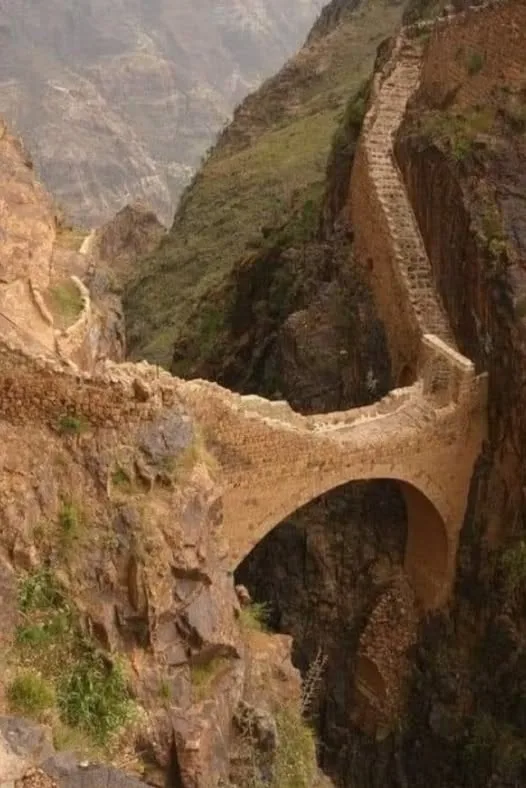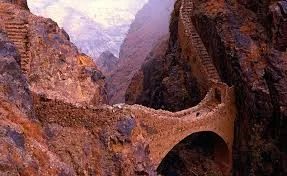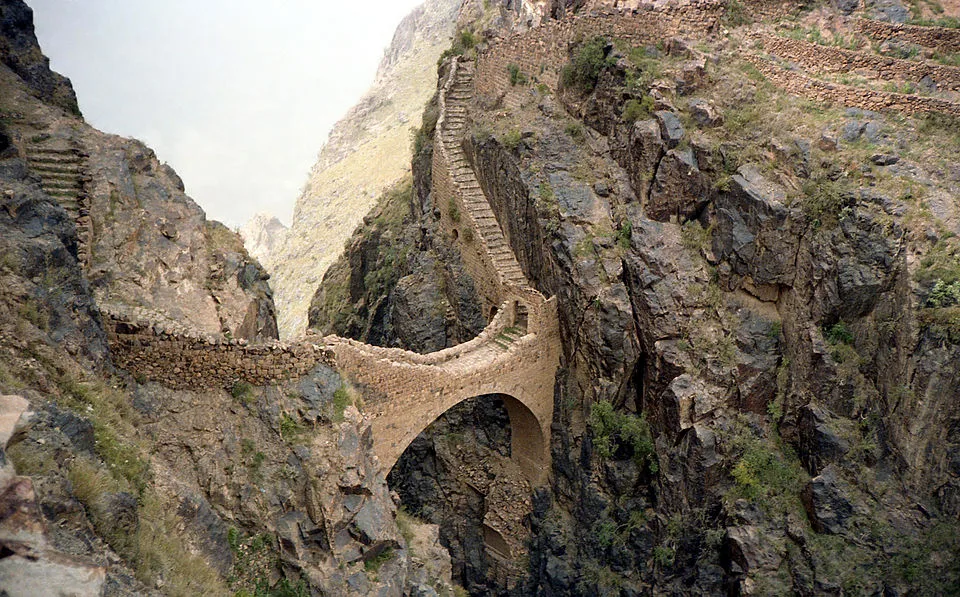Perched in the rugged Ahnum Mountains of northwestern Yemen, the Shaharah Bridge is a 17th-century limestone wonder that spans a 300-foot-deep gorge between Jabal al Emir and Jabal al Faish. This 65-foot-long, 9-foot-wide structure, located in the ‘Amran Governorate about 140 km from Sanaa, is far more than a simple crossing. Designed with a strategic twist to thwart Ottoman invaders, it connects the ancient city of Shaharah to its mountainous surroundings, embodying Yemen’s rich history and engineering ingenuity. Known as the “Bridge of Sighs” for its breathtaking presence, it remains a vital lifeline for local villagers and a symbol of a civilization that has thrived since 5000 BCE.

A Bridge Built for Defense
Constructed in the early 1600s during a period of Ottoman expansion, the Shaharah Bridge was engineered with a remarkable failsafe: it could reportedly be collapsed in minutes to halt an enemy advance. Local legend attributes its design to a Yemeni architect, Saleh Al-Soudi, who ensured the bridge’s keystone structure allowed for rapid disassembly, a defensive tactic to protect Shaharah’s fortified hilltop city. This strategic ingenuity made the bridge both a practical crossing and a military asset, safeguarding the region from conquest while facilitating trade and movement across the treacherous canyon formed where the two mountains converge.

Crafted primarily from limestone, abundant in the Ahnum Mountains, the bridge’s sturdy yet elegant arches blend seamlessly with the rugged landscape. Its narrow 9-foot width and exposed position, with no railings, demand careful passage, yet it has endured centuries of use, weathering Yemen’s seasonal rains and seismic activity.
A Link to Yemen’s Ancient Past
Yemen, at the southern tip of the Arabian Peninsula, is one of the world’s oldest centers of civilization, with archaeological evidence of settlements in its northern mountains dating to 5000 BCE. Unlike the arid peninsula, Yemen’s fertile lands and regular rainfall supported early agriculture and trade, positioning it as a vital hub between East African and Middle Eastern kingdoms. The Ahnum Mountains, home to Shaharah, have been inhabited for millennia, their high peaks offering natural fortresses for communities like the Zaydi tribes, who resisted Ottoman rule.

The Shaharah Bridge, linking Jabal al Emir and Jabal al Faish, served these communities by connecting villages and enabling access to Shaharah, a historic stronghold perched at 2,600 meters. The city, with its ancient cisterns and stone houses, relied on the bridge for commerce and communication, its isolation a shield against invaders.
The Bridge of Sighs
Before Yemen’s civil war disrupted tourism, the Shaharah Bridge was a magnet for adventurers willing to trek 140 km from Sanaa through rugged terrain. Its nickname, “Bridge of Sighs,” captures the awe it inspires—a slender limestone arc suspended over a dizzying gorge, framed by jagged peaks. The view from the bridge, with Shaharah’s ancient skyline and the canyon below, left visitors speechless, evoking both wonder and the vertigo of its perilous crossing.
Even today, the bridge remains in use by locals, who traverse it on foot or with donkeys, carrying goods between villages. Its endurance, despite centuries of exposure and minimal maintenance, speaks to the skill of its builders and the strength of its limestone construction.

A Symbol of Resilience
The Shaharah Bridge is more than an architectural feat—it’s a testament to Yemen’s enduring spirit. Its strategic design reflects a people who balanced survival with innovation, using the landscape to their advantage. As a vital link in the Ahnum Mountains, it connected communities in a region shaped by millennia of civilization, from ancient trade routes to modern struggles. Though war has dimmed its allure as a tourist destination, the Bridge of Sighs stands firm, a silent witness to Yemen’s past and a beacon of its cultural legacy, whispering tales of ingenuity across the gorge.


